 полная версия
полная версияPsychotherapy
The small size of the neuroglia cells makes it easy to understand how movement may take place in them sufficient to bring about separation of neurons. It would not be surprising if they should be more or less actively contractile. Whenever they contract, neuronic filaments which they have been holding apart, come together so as to permit the passage of nervous impulses, if any are flowing at the time. When the neuroglia cells become fatigued or seriously disturbed, they refuse any longer to obey the will in any way, or at least gradually get beyond control, and in their relaxation becoming prolonged, push neurons apart. When a man is very tired it gradually becomes impossible for him to keep awake. This is partly because poisons, produced in the course of fatigue, exhaust the vitality of the neuroglia cells and also of the neurons, so that less energy is required to push these latter apart.
It is easy to understand that the neuroglia cells might well become affected by the various narcotics and intoxicants in such a way as to produce the phenomena of anesthesia and drunkenness. The rapid recovery from anesthetics seems to indicate that it is not neurons, or essential nerve cells, that are so deeply affected, but some extraneous, and less important, mechanism within the brain. The neuroglia theory explains this very well and does away with the difficulty. Certain curious phenomena of hysteria are easily explained on this theory. When there is anesthesia in a member because of hysteria, this anesthesia does not follow the distribution of certain nerves, but is limited by a line in the shape of a cuff drawn round the limb. This indicates that the trouble is not peripheral but central, and that owing to psychic disturbance, all the neurons that receive sensory impulses from a particular portion of the body are so affected by a psychic condition that they are no longer capable of receiving impulses from the periphery. The neuroglia cells in a particular area have passed from the control of the will and, relaxing themselves, have inserted their processes between the terminal filaments of neurons, thus preventing conduction.
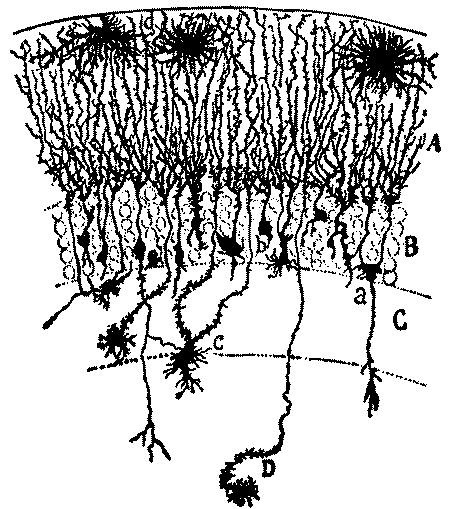
FIG. 15.—NEUROGLIA CELLS OR THE FASCIA DENTATA; IN THE NEW-BORN RABBIT (method of Golgi). A, molecular layer; B, granular layer; C, layer of polymorphis cells; D. horn of ammon; a. neuroglia cell furnished with a descending appendage; b, another neuroglia cell; piroform; c. a cell more deeply situated; d, spider cell; e, fusiform neuroglia cell. (Ramon y Cajal.)
Varieties of Neuroglia .—The connective tissue cells are of many kinds, each probably exercising a special function. Ramon y Cajal has described and pictured a special kind of neuroglia cells for the gray and another for the white matter. In his description of these cells he has pointed out many interesting diversities of form, and probably also of function. He has also described particularly a special form of neuroglia cells which lie close to the blood vessels. These he calls perivascular cells, and they seem to have an important function in regulating the amount of blood that goes to a particular part of the brain. He has written so clearly and yet so concisely with regard to these that it seems better to cite his own words:14
Under the term neuroglia are included at least three kinds of cells,—those of the white brain substance, those of the gray substance, and the perivascular cells, which have been described by Golgi. The neuroglia cells of the white brain material are easily recognizable, being large and with rather prominent, smooth, and sharply outlined processes. As my brother seems to have shown, their object appears to be to furnish an insulating, or, at least, a badly conducting, substance to serve as an interrupter of nerve-currents. They certainly do not represent interstices of true nerve substance through which lymphatic fluid can conveniently find its way.
The neuroglia cells of the gray matter present a very special and highly characteristic appearance. They are of manifold form,—at times star-shaped, at times like a comet drawn out in length. These are the tall cells of von Retzius. They have very numerous prolongations, with a large number of short branched collaterals which give the whole cell the appearance of having feathers projecting from its periphery. These cells have been observed in two different conditions. One is that of relaxation, and the picture is that given above. The other is that of contraction, during which the cell body has more protoplasm in it, and the processes become shorter and thicker, and some of the secondary branches disappear entirely. These cells resemble, in certain ways at least, the pigment cells which occur in the skin of some animals. By means of their contractility, these pigment cells can stretch out their processes while in a state of contraction. It must be remembered that this form of neuroglia cells is most abundantly present in those parts of the brain in which it might be expected that a number of nerve currents would frequently come together. They occur, for example, with special frequency in the molecular layer of the cerebral cortex, where the bundle of pyramidal fibers, with their immense number of terminal nerve-endings, come in contact with one another.
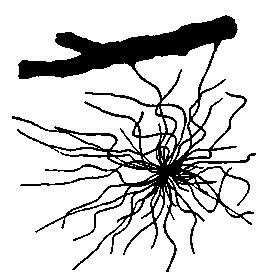
FIG. 16.—NEUROGLIA CELL FROM THE SUBCORTICAL LAYER OF THE CEREBRUM FROM WHICH TWO PROCESSES GO TO A BLOOD VESSEL (Obersteiner).
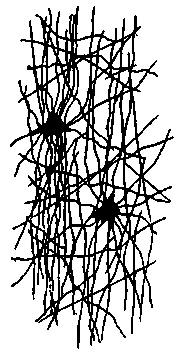
FIG. 17.—NEUROGLIA CELLS FROM THE SPINAL CORD. Longitudinal section (Obersteiner).
The third form of neuroglia cells consists of those known as the perivascular cells. They are found only in the neighborhood of the capillaries of the gray matter and they send one or more firm prolongations to the outer surface of the endothelium of the blood vessels.
These processes are inserted in the walls of the blood vessels. Every capillary has thousands of these little pseudopod prolongations, and from the vessel the cell reaches out in a number of directions. The object of these cells undoubtedly is by contraction of the prolongations to bring about local dilatation of the blood vessels. This dilatation of the blood vessels causes greater or less intensity of the psychical processes in certain parts of the brain, because of the greater or less congestion of the circulation in a part which it produces.
With the exception of these last cells the object of the neuroglia cells is to insulate nerve fibrils and cells from one another. When the cells are relaxed, the passage of a nerve current is either entirely prevented or rendered much less easy than before. It is in this way that the true nature of intellectual rest is explained. Sleep—not only natural sleep, but also artificial narcosis, such as is produced by narcotics, hypnotics or hypnotization—is evidently the result of the same conditions.
During the state of contraction the pseudopod of the neuroglia cells are drawn in; that is to say, the protoplasm of the cells absorbs the processes, and so the true nerve cells and nerve fibrils which were separated from each other by the interposition of neuroglia come into contact. By this mechanism the brain passes from the condition of rest into one of activity. These neuroglia contractions may, particularly in certain parts of the brain, occur automatically. Often, however, they are produced by the action of the will, which, in this manner is able to influence the definite groups of neuroglia cells. As the result of this influence of the will the association of intellectual operations can be guided in various directions. The unusual course that the association of ideas sometimes takes, the flow of words and of thoughts at certain moments, the passing difficulty of speech, the recurrence of tormenting thoughts, the disappearance of expressions or ideas from the memory, even the increase of mental activity and of every kind of motor reaction as well as many other phenomena of intellection, can be satisfactorily explained on this hypothesis. It is only necessary to suppose that in certain parts of the brain the neuroglia cells are at rest, while at other parts they are in a condition of active contraction.
To put it all in a few words, the neuroglia cells of the gray substance of the brain represent an insulating and switching apparatus for nerve currents. They are an insulation apparatus when in a state of contraction, a switching and insulating apparatus when in a state of rest. It is to be remarked, then, that according to this theory the contraction of brain cells does not take place, as in Duval's theory, during intellectual rest, but, on the contrary, during the state of activity of the cerebral cortex. It is much more probable that the action of cells coincides with the active stage of intellection than that brain cellular activity—that is, contraction—should correspond with psychic rest.
The application of some of these theories enables us to understand just how short-circuiting may come about, how many of the curious phenomena of memory happen, and what are the effects, as well as the causes, of attention and distraction of attention and of diversion of mind. It is particularly the latter portion of Ramon y Cajal's theory, with regard to attention and the more or less voluntary though unconscious and usually indeliberate control of blood supply to various portions of the brain, that is of special interest. If the neuroglia cells, whose end plates are attached to blood-vessel walls, become over-contracted or lose their power of relaxation or of contraction, many of the curious phenomena of over-tiredness in neurotic conditions, and the lack of the power of concentration, and sufficient attention to things, can be readily understood. In a word, the theory enables us to translate many expressions that are vague and indefinite, from terms of mind into terms of the physical basis of mind—the anatomy and physiology of the brain.
While I have dwelt on Ramon y Cajal's theory, because for years it has been familiar, of course I must reëcho his own warning that it is, after all, only a theory. It presupposes an active interposition of the glia cells between the axon of one neuron and the dendrons of another. This cannot be demonstrated. A third theory of mental operations, then, has been suggested, and the English school, so ably led by Sherrington ("Integrative Action of the Nervous System," London, 1903) and McDougal ("Synapse Theory of Fatigue," Brain, 1910) has deservedly attracted wide attention. They contend that all the phenomena can be more simply explained without postulating the movement required for the Duval Theory or the glial activity of Ramon y Cajal's hypothesis. They consider that each nerve cell has, as it were, a certain potential energy which it sends forth in nerve impulses. These are transferred from neuron to neuron through the synapse. If what we might call, to borrow a figure from electricity, the voltage of the cell impulse be sufficient to overcome the resistance at the synapse, the impulse passes from neuron to neuron. In fatigue the potential energy of the cell is gradually dissipated. The impulses become feebler till they cease to pass. This occurs in the state we usually experience as tiredness and in analogous states such as sleep, unconsciousness, narcosis and the like. Obviously this theory can be elaborated and applied parallel with the neuroglia theory except that here we are substituting synapse resistance for the hypothetical, undemonstrated action of the glial cells. But, as the latter seems a simpler process upon which to explain the various phenomena, especially to those not familiar with very recent developments in nervous histology and studies in nervous mechanism, and as it merely involves a question of the nature of the resistance and not of its site, I have used it for explanatory purposes without advocating either theory in the present state of our knowledge.
CHAPTER V
BRAIN CELLS AND MENTAL OPERATIONS
While the theories of neuronic action we have discussed do not represent absolute knowledge, they are at least suggestive and helpful in psychotherapy. Whenever there are disturbances of mental operations, patients are likely to become very solicitous, lest these represent organic and incurable changes. The application of Ramon y Cajal's neuroglia theory serves to bring out the fact that most of them can be very well explained as merely functional, due to passing disturbances of activity, and not necessarily to tissue changes. When patients become possessed of the fear that certain nervous symptoms portend definite injuries to the nervous system, this unfavorable suggestion keeps them from using, to its proper and full extent for repair and convalescence, the nervous energy which they possess. This disturbing influence can be counteracted by a straightforward exposition of Ramon y Cajal's or the newer English theory of brain mechanism.
Patients become very much disturbed if they observe a failure of certain faculties in themselves, and are prone to think that such a failure means serious exhaustion or enduring change. The power of attention is one of the faculties often disturbed in neurotic cases and causes patients needless solicitude. Disturbances of memory are the next most alarming elements in these cases. There are then many forms of mental distraction, absorption and preoccupation that sometimes frighten neurotic individuals who have become solicitous about themselves. Though only passing incidents, due to overattention to themselves and their ills, real or fancied, and the consequent lack of concentration of mind on a particular subject, the patients fear serious deterioration of their mental condition, or at least of mental control. The neuroglia theory of mental action throws a light on all these phases of mentality that serves to lessen the solicitude of patients and enable them to understand that, in spite of their fears, there is nothing but functional disturbance. The condition can be readily explained and it admits of complete restoration to health.
ATTENTION
Even more important, perhaps, than any other of the functions attributed to the neuroglia cells, is the rôle they may play in enabling the individual to concentrate attention on a particular subject, or at least to use a particular portion of his brain, by bringing about a more active circulation in that portion than in any other, Ramon y Cajal attributes this power to the perivascular neuroglia cells. Every capillary in the brain has thousands of these little pseudopod prolongations. When the cells in a particular region contract, the blood vessels of the part are pulled wide open and a larger supply of blood flows more freely, stimulating the nerve cells by which it passes and supplying them with nutrition for the expenditure of energy that they may have to make. This is the physical process that underlies attention. When too much, that is, too long-continued attention is paid to any subject, without diversion of mind, the capillaries may easily acquire the habit of being open, and cells the custom of contraction, so that relaxation does not readily take place. Something of this kind is the most important element in the etiology of many functional nervous disorders.
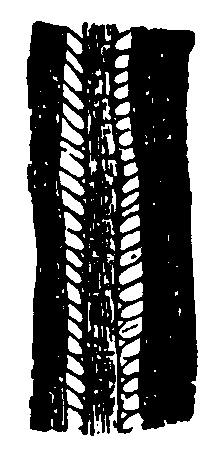
FIG. 18.—AN ARTERY FROM THE CEREBRAL CORTEX.—One can see numerous fine fibers passing over to the brain substance (Obersteiner).
Ease and Pleasure in Mental Operations.—On the other hand this same set of ideas explains many things otherwise difficult of understanding. For instance, we all know that habit enables us to apply ourselves to a particular subject with ever growing ease. What was extremely difficult for us at the beginning, may after a time become comparatively easy, and later even positively pleasant. Study, that is application of mind, is, at the beginning, for most people, not agreeable. If persisted in, it almost inevitably becomes a pleasure. Hard exercise of any kind is, at the beginning, sure to require great energy of purpose, and requires some subsidiary motive of approbation or reward to make us persist in it. But what was a distinct labor at the beginning becomes pleasant after a while. This may be applied to the neuroglia cells apparently as well as to the muscle fibers. On this theory, the reason for the gradual acquirement of an intense pleasure in the intellectual life becomes easy to understand.
Dangers of Over-attention.—The danger of concentration of mind on one's self, quite as much as on any other subject, becomes clearer when this theory is accepted as explaining the physical basis of the mental operations involved in attention. If people allow thoughts of themselves and of their physical processes constantly to occupy their minds, gradually that portion of the brain ruling over these becomes over-fatigued and fails to respond to the calls for relaxation. Insomnia may develop readily as a consequence of continued solicitude and prove to be, as the worst forms of insomnia so often are, quite unamenable to direct drug treatment, because, even during the enforced sleep that comes from drugs, dreams with regard to self and the supposed ills may still occupy the overworked portion of the brain. Nervous people are, most occupied with those parts of the brain which have something to do with the omission and transmission of trophic influence to particular parts of the body. As a consequence of the persistent hyperemia, too many trophic impulses are sent down. These cause an exaggeration of physiological function, in the stomach, the heart, or some other important organ. Hence these organs may become oversensitive.
For all these reasons, this theory of attention, of the great Spanish investigator, deserves to be well known by those who hope to treat neurotic affections, especially functional diseases of the brain, and therefore I prefer once more to give it in his own words.15
Ramon y Cajal's Theory of Attention.—Under usual conditions, the motor apparatus of the gray matter suffices for the explanation or the varied course of association of ideas and of the reaction produced by voluntary motion. But as soon as attention is concentrated upon an idea, or a small number of associated ideas, there enters into the problem, besides the active retraction of the neuroglia of the corresponding part of the brain, a new factor—the active congestion of the capillaries of the over-excited region. As a consequence of this, the energy of emotion reaches a maximum. The heat and metabolism of the hyperemic parts is increased, which, of course, makes these parts capable of more work.
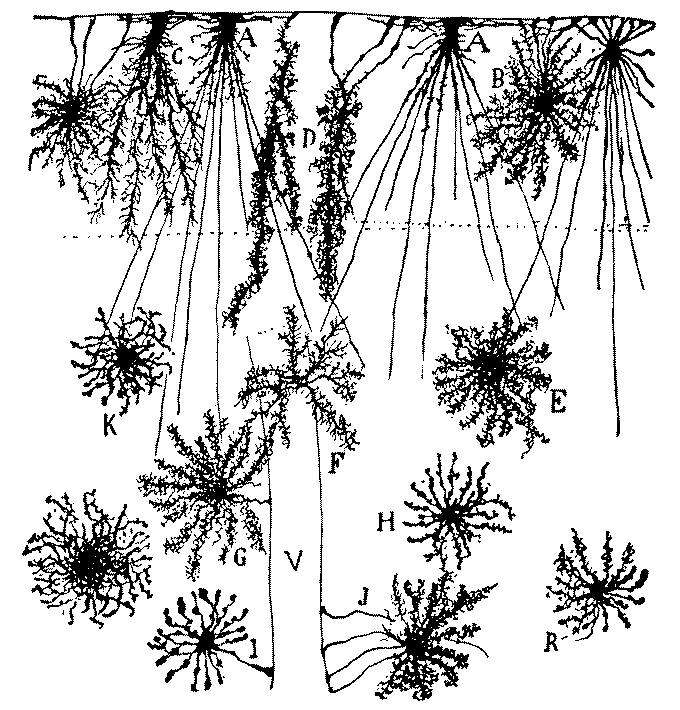
FIG. 19.—NEUROGLIA CELLS OF THE SUPERFICIAL LAYERS OF THE BRAIN FROM AN INFANT AGED TWO MONTHS (method of Golgi). A, B, C, D, neuroglia cells of the plexiform layer; E, F, G, H, K, R, neuroglia cells of the second and third layers; I, J, neuroglia cells with vascular pedicles; V, blood-vessel. (Ramon j Cajal.)
This congestion of various parts of the brain has been experimentally observed by a number of physiologists. It can be best explained by considering that the will has an influence upon the nerves which produce a dilatation of the blood-vessels in different parts of the cerebral cortex. The process of attention, however, by which intellectual activity is concentrated upon a limited number of ideas, seems to be but very little under the control of the sympathetic nerve endings.
As a matter of fact, the capillaries of the brain are wanting in nerves and smooth muscle fibers. Hence they are not under the control of the sympathetic system. Only the relatively large arteries of the pia mater, which possesses a tunica muscularis are under a certain limited control of the sympathetic, which is able to produce in them an incomplete and not very well limited congestion. One of the difficulties of the problem of the activity of the sympathetic is best realized when we recall that vasomotor activity is usually involuntary. The process of attention, however, is entirely conscious and voluntary.
In the hypothesis that we have given, most of the difficulties disappear. Under the influence of the will, the pseudopod branches of the neuroglia cells, which end in the walls of the capillaries, contract. As the result of this, the bloodvessels, all of which are surrounded by lymph spaces, dilate, and this dilatation may proceed to such an extent that the vessels occupy the whole of the lymph spaces. Thus we can easily understand how the very limited congestions which are necessary for the concentration of thought upon a single idea may be brought about.
The perivascular lymph spaces which exist in the brain seem to be for the purpose of making these limited hyperemias easier. At the same time they serve a very useful purpose in preventing pressure or concussion, such as might be caused upon the neighboring nerve cells by too great dilatation of the blood vessels of a part.
It is needless to add that we do not consider the hypothesis that we have advanced to be absolutely without objection. On the contrary we believe that, owing to the difficulty of the problem and our, as yet, extremely slight knowledge of the anatomy and physiology of the nerve protoplasm, any theory as to the special mechanism of psychic processes is sure to be faulty. Rational hypotheses, however, which are supported by well-known facts, are not only justified, but are often fruitful of suggestive ideas. A scientific hypothesis often gives a new direction, suggests an untried method of observation, or hints at new ways of experiment, and, though it may not lead directly to truth, always brings us closer to methods of investigation and of criticism that are invaluable. Even though our further investigations should not confirm our hypothesis, the result will not be less positive. Negative conclusions lessen the number of possible hypotheses and therefore diminish the possibility of error in future investigations.
MEMORY
It is evident that some of the physical mechanisms that are employed for the lower grade mental processes at least can be explained on the neuroglia theory. Memory we share to a great extent with the animals, and for this the physical processes can be rather interestingly studied. We have all had the experience of being unable to recall a word when we wanted it. Commonly the word is a proper name with which there are not many direct connecting ideas, so that, somehow, we seem unable to trace the word to its depository in the brain. Occasionally we are sure that we know the first letter of the word. Sometimes we are able to name this letter, and, if we do so, the rest of the word will usually turn up a moment later. At times, however, the word fails to come and we grope for it. Then if we stop deliberately seeking it, the word will often after a longer or shorter time, come up spontaneously.
This experience is familiar to everyone. It is especially frequent with public speakers. Certain words have a habit of slipping away just when we want them. At times by beginning a sentence confidently, even though there is a feeling that there is a missing word ahead, the word will turn up in time. Often it will not, and then a weak circumlocution must be indulged in. If it is a proper name, a description may have to be substituted, sometimes a confession may have to be made that the name will not come and the audience, unless it is very young, will sympathize with the speaker.
If we accept the idea that the memory has a definite location in the brain, the process is easily understood. Just how we cannot say, but somehow brain cells serve as the media by which our memory processes revert to knowledge that has been previously stored up. If now we assume that the repetition of things known is accomplished by bringing brain cells into connection with one another, and with the organs of speech, it is easy to understand that somehow the connection with a particular cell or set of cells cannot be secured at a given moment. This delay prevents us from being able to repeat things that we know, and know that we know, though we cannot somehow get at them. The will fails to reach the proper insulating plug of a neuroglia cell, which, if acted upon, would put a cell or group of cells in communication with others. As a result the message from it cannot flow down. We feel that we have it on the tip of our tongue, as we say, that a little effort may bring it to us and sometimes that effort succeeds. If there is any disturbance of consciousness by secondary motives, however, as by the excitement of public speaking or the flustering that comes to some people when they try to introduce even old-time friends and forget their names, then we cannot control the brain processes and memory fails. We do not for a moment think of attributing this failure of memory to the faculty of memory itself. We have the feeling that there is some mechanical obstacle. Ramon y Cajal's theory enables us to understand this obstacle better, perhaps, than any other.









